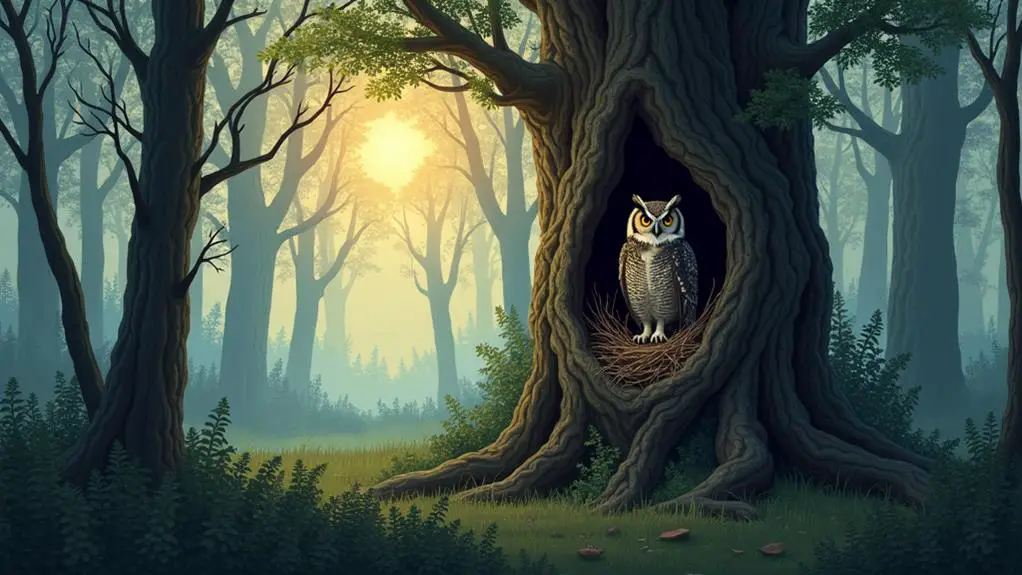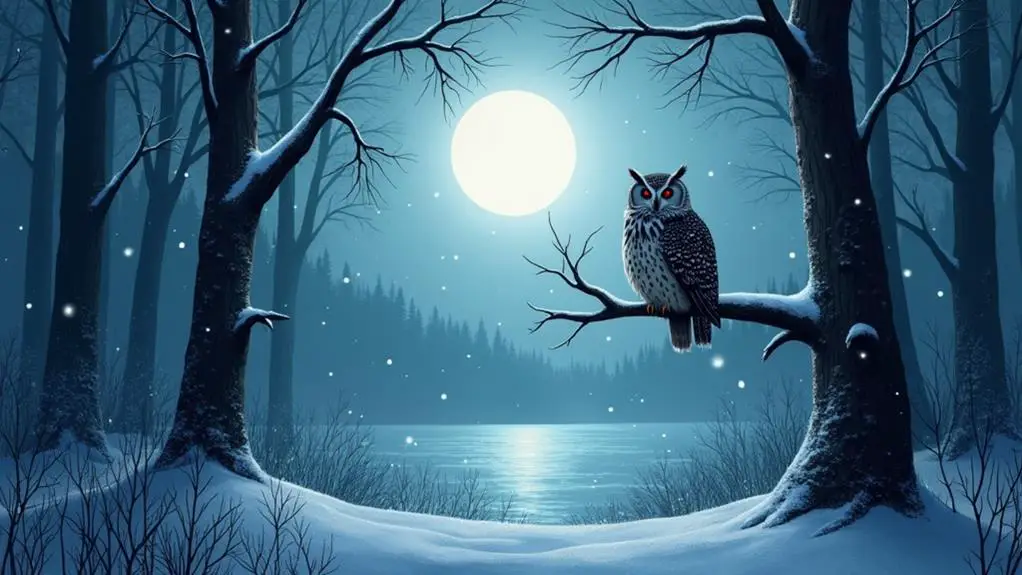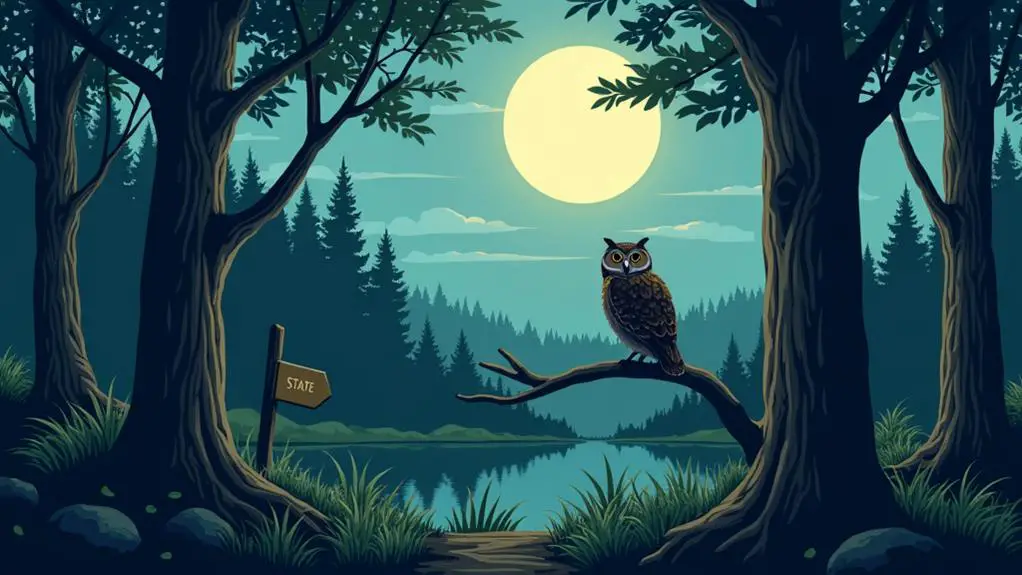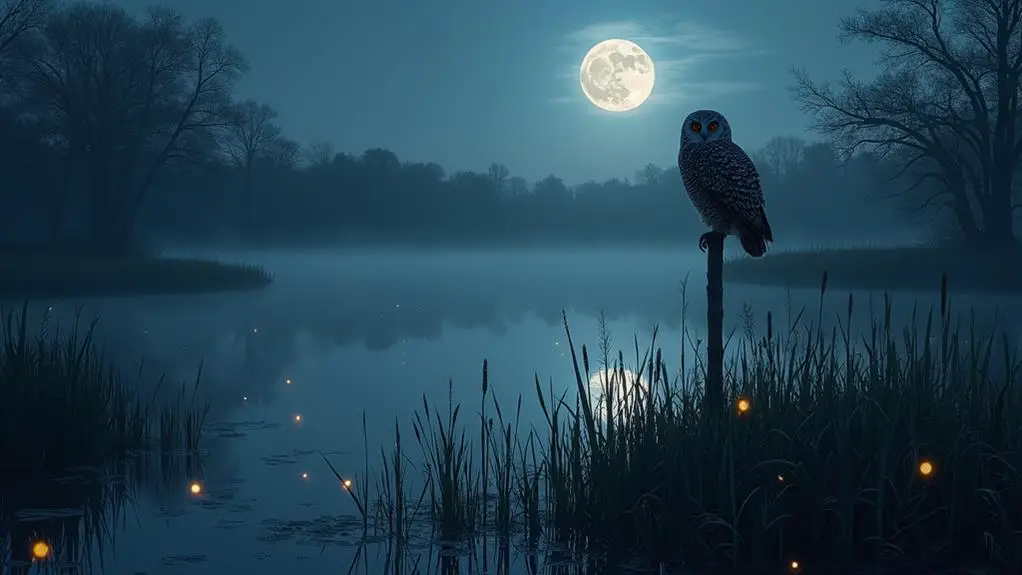As you venture into Wisconsin's rural landscapes, you might catch a glimpse of an owl perched atop a towering tree or swooping silently through the night. It's no coincidence that these mysterious birds are thriving in the Badger State. Wisconsin's unique combination of habitat diversity, abundant food sources, and ideal climate conditions create a haven for owls. But what specific factors contribute to their success? Is it the state's conservation efforts, the varied terrain, or something more? You're about to uncover the secrets behind Wisconsin's owl population boom, and the answers might just surprise you.
Key Takeaways
- Wisconsin's diverse landscape provides an ideal environment for owls, with varied habitats supporting a wide range of species.
- Abundant food sources, including rodents, insects, and aquatic life, support owl populations and provide a reliable source of sustenance.
- Conservation efforts, such as the Nongame Wildlife Program and habitat preservation initiatives, have contributed to thriving owl populations in Wisconsin.
- Owls have adapted exceptionally well to Wisconsin's climate, with warmer winter nights and ideal humidity levels allowing them to conserve energy and thrive.
- Unique geography and minimal human disturbance areas provide owls with ample space to roam, hunt, and nest without disturbance, supporting their populations.
Wisconsin's Diverse Landscape Benefits

Across Wisconsin's diverse landscape, from the northern forests to the southern prairies, lies a unique blend of ecosystems that provide an ideal environment for owls to thrive.
You'll find that the state's varied terrain, which includes wetlands, grasslands, and forests, creates a complex mosaic of habitats that support a wide range of owl species.
The landscape's fragmentation, resulting from human activities like agriculture and urbanization, has led to the creation of edge habitats.
These transitional zones between different ecosystems provide owls with an abundance of resources, such as perches, nesting sites, and hunting grounds.
The juxtaposition of different habitats also allows owls to exploit different prey populations, increasing their overall fitness.
As you explore Wisconsin's diverse landscape, you'll realize that the state's unique geography has created a perfect setting for owls to flourish.
The varied topography, combined with the presence of edge habitats, provides owls with the necessary resources to survive and thrive.
This complex interplay of landscape features has contributed significantly to the state's owl populations, making Wisconsin an ideal location for these birds of prey.
Abundant Food Sources Galore
You'll find that Wisconsin's abundant food sources are a major draw for owls, with a rodent population that's exploding in number, providing a reliable source of sustenance.
Additionally, the state's varied landscapes offer ample insect supplies, from grasslands to forests, which support a diverse range of invertebrate species.
Furthermore, Wisconsin's wetland habitats, including marshes and swamps, are particularly fruitful, supporting a rich variety of aquatic life that owls can't resist.
Rodent Population Explodes
Several decades of mild winters and abundant precipitation have created a perfect storm for Wisconsin's rodent population, which has exploded in recent years. You might be wondering what's behind this surge. The answer lies in the state's pest control strategies and farming practices.
| Factor | Impact on Rodent Population |
|---|---|
| Relaxed pest control measures | Less culling of rodent populations, allowing them to thrive |
| Increased crop yields | Abundant food sources for rodents, supporting their growth |
| Shift to conservation tillage | Reduced soil disturbance, creating ideal habitats for rodents |
The relaxation of pest control measures has allowed rodent populations to grow unchecked. Meanwhile, Wisconsin's farming practices have created an environment conducive to rodent growth. The increased crop yields provide an abundance of food, while the shift to conservation tillage has reduced soil disturbance, creating ideal habitats for rodents. As a result, you're seeing a rodent population boom, which has significant implications for the state's ecosystem and, ultimately, the thriving owl population.
Ample Insect Supplies
Prosperity for Wisconsin's owl population is closely tied to the abundance of insects that thrive in the state's ecosystems.
You'll find a staggering array of insects, from beetles to moths, providing a veritable feast for owls. Bug diversity is particularly high in Wisconsin's forests, grasslands, and wetlands, with over 20,000 known insect species.
This diversity translates to a constant supply of food for owls, which are skilled hunters that can adapt to changing insect populations.
Insect behavior also plays a crucial role in owl success. Many insects, like crickets and katydids, are nocturnal, making them prime targets for owls that hunt at night.
Additionally, insects that live in or near water, such as aquatic beetles and caddisflies, are often abundant near owl habitats. The insects' behavior, such as their movement patterns and aggregation habits, can also make them more vulnerable to owl predation.
With such an abundance of insects and their diverse behaviors, it's no wonder that Wisconsin's owl population is thriving.
Fruitful Wetland Habitats
Wisconsin's wetlands provide a bounty of food sources, often teeming with small mammals, amphibians, and reptiles that owls prey upon.
As you venture into these areas, you'll notice the diverse aquatic plants, including cattails, water lilies, and sedges, which serve as hiding spots for prey.
The dense marsh vegetation, comprising reeds, grasses, and shrubs, creates a sheltered environment for owls to hunt and nest.
The wetlands'-edge habitats, characterized by a mix of open water and emergent vegetation, attract a wide range of prey species.
You might spot muskrats, raccoons, and snakes, which owls can swoop down upon with stealth and precision.
The abundance of food in these areas allows owls to thrive, with some species, like the barn owl, relying heavily on wetland habitats for their survival.
Ideal Nesting and Breeding Grounds

Owls in Wisconsin thrive in diverse habitats, but they're particularly drawn to areas with specific characteristics that provide ideal nesting and breeding grounds.
When you're out in the field, you'll notice that owls often favor stands of mature trees, especially those with cavities or hollows. These tree cavities serve as perfect nesting sites, offering protection from harsh weather and predators.
You'll also observe that owls tend to return to the same nesting sites year after year, exhibiting strong site fidelity. This nesting habit is crucial for successful breeding, as it allows owls to establish a stable home base for raising their young.
When examining owl nesting habits, you'll see that they often choose trees with dense canopies, which provide cover for their nests. Additionally, owls prefer areas with minimal understory vegetation, making it easier for them to move around and hunt.
Minimal Human Disturbance Areas
As you explore owl habitats in Wisconsin, you'll find that minimal human disturbance areas play a vital role in their nesting and breeding success. These areas provide silent refuges and secluded enclaves where owls can thrive without human interference.
| Feature | Description |
|---|---|
| Undeveloped Land | Large tracts of land with minimal human activity, providing ample space for owls to roam and hunt |
| Mature Forests | Dense, mature forests with complex canopies, offering shelter and protection from predators |
| Wetlands | Marshes, swamps, and bogs with slow-moving water, providing a haven for owls to hunt and nest |
| Remote Areas | Isolated regions with limited human access, allowing owls to breed and nest without disturbance |
In these areas, owls can focus on finding food, raising their young, and defending their territories without the stress of human presence. By preserving and protecting these minimal human disturbance areas, Wisconsin provides an ideal environment for owls to flourish.
Climate Conditions Favor Owls

You'll find that Wisconsin's climate conditions create an ideal environment for owls.
Warmer winter nights, with average temperatures ranging from 14°F to 30°F (-10°C to -1°C), allow owls to conserve energy and survive the harsh season.
Additionally, the state's ideal humidity levels, ranging from 60% to 80%, enable owls to thrive and maintain their plumage.
Warmer Winter Nights
Rising global temperatures are altering the winter landscape in Wisconsin, creating a more hospitable environment for owls.
You might be wondering how this shift benefits these nocturnal birds. Warmer winter nights, for instance, allow owls to conserve energy they'd otherwise expend to stay warm.
This energy conservation translates to increased hunting success, as they can spend more time scanning for prey under the cover of darkness. Additionally, warmer temperatures reduce the frequency and severity of cold snaps, which can be detrimental to owl populations.
These milder winters also lead to the formation of winter microclimates, where areas with unique temperature and humidity profiles provide owls with sheltered spots to roost and hunt. Furthermore, the altered winter landscape results in a more stable food supply, as warmer temperatures enable rodents and other small mammals to remain active, providing a steady source of prey for owls.
These cumulative effects contribute to the thriving owl populations in Wisconsin, making the state an ideal habitat for these birds.
Ideal Humidity Levels
Wisconsin's humid continental climate, characterized by cold winters and warm summers, provides ideal humidity levels for owls. As you explore the state's climate, you'll notice that the relative humidity is typically between 60% and 80%. This range allows owls to thrive, as it enables them to maintain their feathers' insulating properties and regulate their body temperature efficiently.
| Season | Relative Humidity | Atmospheric Pressure |
|---|---|---|
| Spring | 65-75% | 1013-1018 mbar |
| Summer | 70-80% | 1010-1015 mbar |
| Autumn | 60-70% | 1015-1020 mbar |
| Winter | 55-65% | 1020-1025 mbar |
| Average | 65-75% | 1013-1018 mbar |
You'll observe that the atmospheric pressure in Wisconsin ranges from 1010 to 1025 millibars, which is suitable for owls. This pressure range allows them to fly efficiently, using the wind currents to their advantage. The ideal humidity levels and atmospheric pressure in Wisconsin create a perfect environment for owls to hunt, nest, and roost, contributing to their thriving population in the state.
Natural Predator Control Balance
Maintaining a delicate balance in ecosystems, owls play a crucial role as natural predators, regulating prey populations to prevent overgrazing, degradation of habitats, and potential extinctions.
As you explore the Wisconsin wilderness, you'll notice that owls are thriving, and it's largely due to their ability to maintain this balance.
Owls' predator dynamics are intricately linked with prey behavior.
They prey on species that might otherwise overpopulate, causing harm to their own populations and the environment. This, in turn, affects the prey's behavior, making them more vigilant and cautious.
For instance:
- Vulnerable species: Owls prey on species that are vulnerable to disease or environmental changes, preventing their populations from spiraling out of control.
- Habitat preservation: By regulating prey populations, owls help preserve habitats, preventing overgrazing and maintaining ecosystem diversity.
- Ecosystem resilience: Owls' predation helps ecosystems recover from disturbances, such as natural disasters or climate change.
- Biodiversity protection: By controlling prey populations, owls protect biodiversity, ensuring that no single species dominates the ecosystem.
State Conservation Efforts Pay Off

As you venture into Wisconsin's wilderness, you're likely to notice the thriving owl populations, and it's no coincidence that their numbers are on the rise.
State conservation efforts have played a significant role in this upward trend. Wisconsin has a rich conservation history, with dedicated state funding allocated towards protecting and preserving natural habitats.
Since the 1960s, the state has implemented various conservation programs, including the Nongame Wildlife Program, which focuses on protecting non-hunted species like owls. This program has received consistent state funding, enabling conservationists to conduct research, monitor populations, and develop effective management strategies.
Additionally, the Wisconsin Department of Natural Resources has collaborated with local organizations and landowners to create owl-friendly habitats, further supporting the growth of owl populations.
These concerted efforts have contributed significantly to the thriving owl populations in Wisconsin, making it an ideal habitat for these magnificent birds.
Habitat Preservation Initiatives
You'll explore three key habitat preservation initiatives that support Wisconsin's owl populations:
Wetland restoration efforts, which focus on rehabilitating degraded habitats and promoting biodiversity;
Forest management strategies, which aim to maintain suitable tree densities and species compositions;
And wildlife corridor creation, which involves connecting fragmented habitats to facilitate owl movement and dispersal.
Wetland Restoration Efforts
Wisconsin's wetlands, crucial habitats for its owl populations, have faced significant degradation and loss over the years.
You might be wondering how this affects the owls, but fortunately, restoration efforts are underway to revitalize these vital ecosystems.
Wetland restoration involves designing habitats that mimic natural conditions, ensuring optimal water quality and flow rates.
This entails removing invasive species, reintroducing native vegetation, and creating buffers to filter pollutants from runoff water.
By doing so, you're providing owls with a healthy environment to thrive in.
- Habitat loss: Owls are left without a place to roost, hunt, and breed.
- Water pollution: Toxic substances contaminate the food chain, affecting owl health and reproduction.
- Disrupted ecosystem balance: The delicate balance of predator and prey is upset, leading to population declines.
- Loss of biodiversity: Unique plant and animal species disappear, reducing the ecosystem's resilience.
Through concerted wetland restoration efforts, Wisconsin is giving its owls a fighting chance to flourish.
Forest Management Strategies
Forest management strategies play a vital role in preserving owl habitats, as they focus on maintaining healthy forest ecosystems that provide owls with the resources they need to survive.
You're likely familiar with traditional forestry practices that prioritize timber production, but ecological silviculture takes a more nuanced approach.
This method prioritizes biodiversity and ecosystem health, creating a more resilient forest that benefits owls and other species.
Wildlife Corridor Creation
As ecological silviculture promotes a healthier forest ecosystem, wildlife corridor creation emerges as a crucial habitat preservation initiative, ensuring that owls and other species can move freely through the landscape.
You're helping to combat habitat fragmentation, a significant threat to biodiversity, by preserving connectivity between isolated habitats. This allows owls to migrate, find food, and breed without facing barriers.
- Owls can fly long distances, but even they can't overcome the obstacles caused by human activities like urbanization and infrastructure development.
- Fragmented habitats lead to inbreeding, reduced populations, and increased competition for resources.
- By preserving corridors, you're giving owls a chance to thrive, and their presence indicates a healthy ecosystem.
- Your efforts contribute to a larger conservation strategy, safeguarding the delicate balance of Wisconsin's ecosystem.
Limited Owl-Human Conflict Zones

While establishing owl-friendly habitats, it's essential to identify areas where human activities and owl territories overlap, thereby minimizing conflicts. You'll want to pinpoint zones where urban boundaries and rural enclaves intersect, as these areas often experience high levels of human-owl interaction. By doing so, you can implement measures to reduce conflicts and ensure the well-being of both humans and owls.
| Zone Type | Characteristics |
|---|---|
| Urban Boundaries | High human population density, noise pollution, and light pollution |
| Rural Enclaves | Low human population density, fragmented habitats, and limited resources |
| Overlap Zones | Areas where urban and rural environments intersect, resulting in increased human-owl interactions |
In these overlap zones, it's crucial to implement conflict-mitigation strategies, such as owl-friendly building designs, minimized lighting, and reduced noise pollution. By taking these steps, you can create an environment where humans and owls can coexist peacefully, allowing owl populations to thrive in Wisconsin.
Evolutionary Adaptations Thrive
Nearly 20 species of owls in Wisconsin have evolved remarkable adaptations to thrive in their environments.
As you explore the state's diverse landscapes, you'll notice that owls have developed unique traits to survive and flourish.
Some of these remarkable adaptations include:
- Exceptional Night Vision: Owls' eyes are specifically designed to gather and focus light, allowing them to hunt effortlessly in low-light conditions.
- Silent Flight: The unique wing structure of owls, featuring soft fringes and serrations, enables them to fly quietly, sneaking up on unsuspecting prey.
- Acute Hearing: Owls can pinpoint the faintest sounds, thanks to their asymmetrical ear placement and extremely sensitive hearing organs.
- Camouflage and Stealth: Many owl species have evolved to blend seamlessly into their surroundings, making them expert hunters and difficult to spot for predators or humans.
These adaptations have enabled owls to thrive in Wisconsin's varied ecosystems, from dense forests to open grasslands.
As you venture into the state's wild spaces, keep an ear out for the soft hooting of owls, and remember, they're watching you, too.
Frequently Asked Questions
Do Owls in Wisconsin Migrate or Stay Year-Round?
You'll find that owls in Wisconsin exhibit varying migration patterns, with some species, like the Snowy Owl, migrating from Arctic breeding grounds, while others, like the Great Horned Owl, remain year-round residents, with minimal migration.
How Do Owls Protect Themselves From Harsh Winters?
As you venture into the frozen landscape, you'll find owls donning frosty feathers, blending seamlessly into winter camouflage, their silent sentinels guarding against harsh winds and icy grip, adapting to survive the biting cold with precision and stealth.
Are Wisconsin Owls Susceptible to Diseases Like West Nile Virus?
You're wondering if Wisconsin owls are susceptible to diseases like West Nile virus; the answer lies in their immune systems. Viral transmission occurs through mosquito bites, but owls' robust immune systems often help them fight off the infection, reducing disease severity.
Can Owls Be Kept as Pets in Wisconsin?
Imagine having a wise owl as a companion! However, you shouldn't get your hopes up – in Wisconsin, owl bonding is a myth, and pet licensing is heavily regulated, making it extremely difficult for you to legally keep an owl as a pet.
How Do Owls Communicate With Each Other in the Wild?
You observe that owls communicate with each other through vocalizations patterns, such as hooting, whistling, and screeching, which convey information about territory, prey, and mates, while their silent hunters' skills allow them to stalk prey undetected.
Conclusion
As you explore Wisconsin's owl-friendly landscape, it's clear that this haven has everything these birds need to thrive. The state's diverse terrain, abundant food sources, and ideal climate create a perfect storm of conditions that let owls flourish. Add to that the state's conservation efforts and minimal human disturbance, and it's no wonder Wisconsin's owl populations are flying high. It's a true avian paradise, where these magnificent creatures can live life to the fullest, free from the threats that plague them elsewhere.





